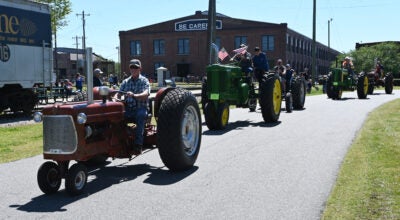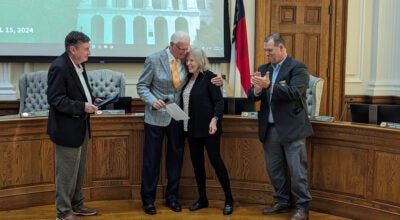Radio users gather for training
Published 12:00 am Saturday, June 25, 2011
By Hugh Fisher
hfisher@salisburypost.com
SALISBURY — Suppose the unthinkable were to happen. What if a major tornado wiped out Salisbury the way Joplin, Mo., was devastated last month?
Or what if an emergency at the McGuire Nuclear Station forced an evacuation, like the one following the Japanese tsunami in March?
The first line of communication with the outside world would be amateur radio operators.
This weekend, a group of local radio operators from the Amateur Radio Emergency Service, or ARES, are holding a Field Day competition at the Elizabeth Hanford Dole Chapter of the American Red Cross.
It’s part fun, part training for the radio operators.
And it’s a chance for the public to stop in and see how radio operators can use a small amount of electronics to talk around the world.
Around the clock
The ARES Field Day is a 24-hour, non-stop competition.
Using equipment just like what they would use in an emergency, radio operators see how many other stations they can contact, and how far away.
Outside the Red Cross building, an antenna made of wire, held in place by cable, stretches longways from the roof of the building to a shed out back.
Two other, smaller antennas have been erected nearby.
Inside, a row of tables holds radios, microphones, power supplies and laptop computers.
“November Four Tango, please copy,” radio operator Jared Gohlke says into his microphone.
That’s radiospeak for N4T, the call sign for this Field Day.
A reply comes back over his headset.
“Roger that,” Gohlke answers, “we are Two Foxtrot, November Charlie.”
That’s his way of telling the person on the other end that the event is broadcasting from North Carolina using commercial power.
The group will score points for each of the contacts made with operators across the U.S. and elsewhere.
During the afternoon, local amateurs talked to operators in Ontario, Canada and states as far west as Colorado.
They could hear radios in Nicaragua and Puerto Rico, but couldn’t get an answer right away.
That sometimes happens, said Gary Lang, district emergency coordinator for Area 11 — a seven-county area of North Carolina, including Rowan and Cabarrus.
He’s also a volunteer firefighter for Franklin Township and a spotter for the National Weather Service’s Skywarn program.
When a tornado touched down near U.S. 601 north of Salisbury in April, Lang helped radio in reports of the damage.
Fast responders
Lang said that amateur radio operators are the first line of communication when a disaster happens.
“If the typical communication systems go down, we can tell (responders) where to go,” Lang said.
Many public safety agencies are switching to 800 mhz radio networks, Lang said.
“They work great if you’re on flat land,” he said.
But different agencies use different types of radios and frequencies.
“Remember 9/11?” he asked.
During and after the terrorist attacks, New York’s firefighters, police and EMS responders couldn’t communicate directly.
With state-of-the-art handheld radios and portable sets, volunteers can help out in the first stages of a disaster.
If power, cellular phones and even Internet connections go down, radios can take over.
Not just voice
Lang said today’s “ham radios” can send email and text over the air if data lines are cut.
It’s slow, Lang said — about the speed of an older dial-up modem — but it could save lives.
Gohlke, emergency coordinator for ARES, said amateur radio plays an important behind-the-scenes role.
“A lot of folks don’t know we exist,” he said.
But amateur radio operators can make contacts across the world, and even in space.
There’s a radio transceiver on the International Space Station, he said.
“I’ve talked with people around the world,” he said.
Getting involved isn’t difficult. Licensing requirements are much less strict than they used to be, Lang said.
For example, you don’t have to learn Morse code anymore, though it’s still widely used.
And you don’t need expensive technology.
Small, handheld high frequency radios, about the size of walkie-talkies, can be used to talk several counties away with the help of a repeater, a larger, more powerful antenna.
And though you can find powerful radios and antennas costing thousands of dollars, you can get just as much fun out of a $100 radio and an antenna made from scrap wire, cut to length, and some inexpensive parts.
Outside in the Red Cross parking lot, Lang showed an antenna he made from pieces of an old tape measure, some PVC pipe and components you’d find at an electronics store.
Gohlke said local amateur radio clubs are a great way to learn about this hobby.
It’s a hobby, he said, that can also save lives.
“It’s a good way to serve your community,” he said.
Contact Hugh Fisher via the editor’s desk at 704-797-4244.




